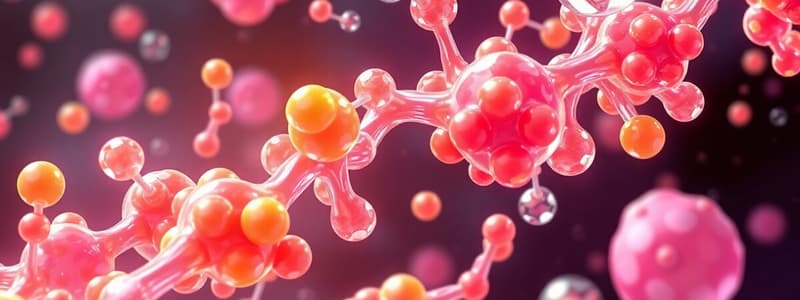Podcast
Questions and Answers
What type of reaction combines simple sugars into complex carbohydrates?
What type of reaction combines simple sugars into complex carbohydrates?
- Dehydration synthesis (correct)
- Oxidation
- Hydrolysis
- Condensation
Which complex carbohydrate is used by plants for energy storage?
Which complex carbohydrate is used by plants for energy storage?
- Starch (correct)
- Chitin
- Cellulose
- Glycogen
What distinguishes glucose from fructose despite having the same chemical formula?
What distinguishes glucose from fructose despite having the same chemical formula?
- Number of carbon atoms
- Molecular weight
- Presence of nitrogen
- Arrangement of atoms (correct)
Which carbohydrate serves a structural role in plant cell walls?
Which carbohydrate serves a structural role in plant cell walls?
What process breaks down complex carbohydrates into simple sugars using water?
What process breaks down complex carbohydrates into simple sugars using water?
What is the primary function of glycogen in animals?
What is the primary function of glycogen in animals?
What type of macromolecules are carbohydrates classified as?
What type of macromolecules are carbohydrates classified as?
What elements primarily compose carbohydrates?
What elements primarily compose carbohydrates?
How does the structure of starch differ from cellulose?
How does the structure of starch differ from cellulose?
What type of monomer forms carbohydrates?
What type of monomer forms carbohydrates?
What characteristic of water is primarily due to the unequal distribution of shared electrons?
What characteristic of water is primarily due to the unequal distribution of shared electrons?
What type of bond forms between water molecules because of their polarity?
What type of bond forms between water molecules because of their polarity?
Which property of water explains why insects can walk on its surface?
Which property of water explains why insects can walk on its surface?
How does water interact with hydrophilic molecules?
How does water interact with hydrophilic molecules?
What is the measure of how difficult it is to break the surface of a liquid called?
What is the measure of how difficult it is to break the surface of a liquid called?
What distinguishes a polar molecule from a charged atom or molecule?
What distinguishes a polar molecule from a charged atom or molecule?
What role does the polarity of water play in plant water transport?
What role does the polarity of water play in plant water transport?
What type of molecules do not interact with water?
What type of molecules do not interact with water?
What is the primary reason molecules stick to each other in water?
What is the primary reason molecules stick to each other in water?
Which of the following statements about water is incorrect?
Which of the following statements about water is incorrect?
Flashcards
Carbohydrates
Carbohydrates
Large organic molecules made up of chains of simple sugars.
Monosaccharides
Monosaccharides
The building blocks of carbohydrates. They are simple sugars.
Dehydration Synthesis
Dehydration Synthesis
The process of linking simple sugars together to form larger carbohydrate molecules. It involves the removal of water.
Hydrolysis
Hydrolysis
Signup and view all the flashcards
Glycogen
Glycogen
Signup and view all the flashcards
Cellulose
Cellulose
Signup and view all the flashcards
Starch
Starch
Signup and view all the flashcards
Isomers
Isomers
Signup and view all the flashcards
Structure of Carbohydrates
Structure of Carbohydrates
Signup and view all the flashcards
Linear vs. Branched Carbohydrates
Linear vs. Branched Carbohydrates
Signup and view all the flashcards
Covalent bond
Covalent bond
Signup and view all the flashcards
Polar molecule
Polar molecule
Signup and view all the flashcards
Hydrogen bond
Hydrogen bond
Signup and view all the flashcards
Cohesion
Cohesion
Signup and view all the flashcards
Adhesion
Adhesion
Signup and view all the flashcards
Surface tension
Surface tension
Signup and view all the flashcards
Hydrophilic
Hydrophilic
Signup and view all the flashcards
Hydrophobic
Hydrophobic
Signup and view all the flashcards
Aqueous fluids
Aqueous fluids
Signup and view all the flashcards
Water transport in plants
Water transport in plants
Signup and view all the flashcards
Study Notes
Carbohydrates
- Carbohydrates are organic macromolecules built from chains of simple sugars covalently bonded together.
- These polymers can be linear or branched, and function in energy storage or building structural components.
- Simple sugars contain carbon, hydrogen, and oxygen.
- The arrangement of atoms in a sugar monomer determines its structure and properties (e.g., glucose and fructose are isomers with the same chemical formula C₆H₁₂O₆ but different arrangements).
- Sugar monomers join via dehydration synthesis, where water is lost and covalent bonds form.
- Different arrangements of glucose monomers create various complex carbohydrates like starch, glycogen, and cellulose.
- Cellulose (linear chains) forms plant cell walls; starch (branched) stores energy in plants, and is digested to glucose in animals.
- Glycogen (branched) is an animal energy storage carbohydrate.
- Hydrolysis breaks complex carbs into simple sugars by adding water and breaking covalent bonds.
Water
- Water is essential for all known life forms.
- A water molecule (H₂O) has two hydrogen atoms and one oxygen atom covalently bonded.
- Covalent bonds result from atoms sharing electrons.
- Water is polar due to unequal electron sharing (oxygen is more electronegative).
- This polarity creates partial positive and negative charges on the water molecule.
- Hydrogen bonding occurs between water molecules due to their polarity.
- Cohesion is water's attraction to itself, leading to high surface tension.
- Surface tension results from hydrogen bonds at the surface.
- Adhesion is water's attraction to other polar molecules or charged ions.
- Cohesion and adhesion combined help water move in plants against gravity.
- Water interacts with hydrophilic (water-loving) and hydrophobic (water-fearing) molecules.
- Aqueous fluids in cells and their environments are affected by water properties that allow for material balance and transport.
Studying That Suits You
Use AI to generate personalized quizzes and flashcards to suit your learning preferences.




